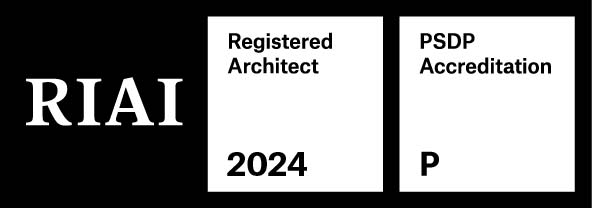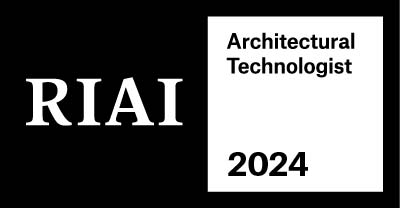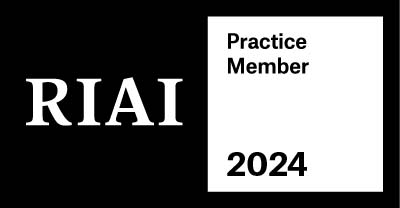The Royal Institute of the Architects of Ireland (RIAI)
Founded in 1839, the RIAI is the representative body for professionally qualified architects in Ireland, and is designed by the State as the Competent Authority for the Architectural Profession in Ireland in relation to the EU Architects Directive. A high standard of profession competence among RIAI member is required through examination prior to admission and maintained by informative programmes and obligatory continuing professional development. “An architect does a lot more than just provide you with a set of drawings, they will help you set a viable brief and budget, guide you through the planning process, obtain quotes for the work, manage consultants like surveyors and engineers, monitor the budget and administer the construction contract. Working with a professionally qualified and RIAI-registered architect will be the best investment you will make as part of the building project.Architects are professionally educated for seven years in design and trained to look at your project from many angles:
- They will find the best solutions for optimising light, space and storage; they will identify appropriate materials and construction methods; and they will seamlessly integrate measures for better energy performance.
- Architects will guide you expertly through a design and building process that can appear to be daunting, indentifying your requirements and protecting your interests.
- An RIAI-registered architect will ensure that your project is dealt with efficiently and competently from planning and design to construction and completion.
- Involving an architect early on in a project can actually save you time and money. They will offer you a range of options and discuss with you the most economic and appropriate design for your requirements.
- Even on small projects, such as a kitchen extension or an attic conversion, working with an architect can make a big difference, as they will find solutions that will realise the full potential of your home”. Source WWW.RIAI.IE
Construction Safety
Project Supervisors for the Design Stage (PSDP) and Project Supervisors for the Construction Stage (PSCS)
Under the Safety, Health and Welfare at Work (Construction) Regulations 2013 Home owners commissioning construction work must appoint PSDP and PSCS for their projects. Edge Architecture will brief the client of their statutory obligations, however further information is available at www.hsa.ie In respect Project Supervisor for the Design Stage (PSDP), Edge Architecture Ltd can provide a service to address the client statutory obligations.
Planning Permission
When do I need planning permission?
Generally, you need planning permission for any development of land or property unless the development is specifically exempted from this need. Development includes the carrying out of works (building, demolition, alteration) on land or buildings and the making of a material (i.e. significant) change of use of land or buildings.
What is exempted development?
Exempted development is development for which planning permission is not required. Categories of exempted development are set out in planning law. There are usually certain thresholds relating to, for example, size or height. Where these thresholds are exceeded, the exemptions no longer apply.
Are there different types of permission?
Yes. There are two types of planning permission. An application may be made for: permission; or outline permission; The most common type of application made is for permission, sometimes referred to as full permission. There are circumstances when you may want to make an application for outline permission. For example, you may want to see whether the planning authority agrees with your proposal in principle before you go to the trouble of making detailed plans. If you obtain outline permission, you must obtain full permission before starting work. In most cases, a subsequent application for permission must be made within 3 years of the date of grant of outline permission. However outline permission cannot be sought for retention of a structure, works to a protected structure or a proposed protected structure or developments which require an environmental impact assessment, integrated pollution control licence or a waste licence.
How long will it take to get planning permission?
This will be affected by the completeness of the application and by whether there is an appeal or not. Generally, a valid application will be dealt with by a planning authority in 12 weeks from the date the application is made to the final grant of a permission. However, the period can vary, particularly if the planning authority seeks further information from the applicant (which it should do within the first 8 weeks). The planning authority then has 4 weeks from the day the further information is received to make a decision on the application. The following table illustrates the timescale involved in most cases.
Timescale Action
- Start Notice published in newspaper and site notice erected
- 2 weeks later Latest date for lodging application
- Between 2 weeks Application is validated by the and 5 weeks planning authority. Submissions or
- objections are considered.
- Between 5 Planning authority issue notice of and 8 weeks later their decision on the application.
- (Alternatively, they may request further information.)
- 4 weeks after If no appeal is made, the planning issue of notice authority will issue grant of
- of decision. permission, or outline permission, except where they have already indicated a decision to refuse.
Are there penalties for breaches of planning law?
Yes. It is an offence to undertake any work needing permission without that permission. Planning authorities have powers to stop unauthorised development and this can be a costly experience for the offender. You may be required to rectify any unauthorised works and will have to pay whatever costs are involved. On conviction in the District Court, fines of up to €1905 can be imposed together with fines of up to €507 per day for continuing offences or to a term of imprisonment of 6 months. On conviction in the Higher Courts, the maximum fine is €12,700,000 (€12,700 per day for
What is a protected structure?
A protected structure is a structure or part of a structure that a planning authority considers to be of special interest from an architectural, historical, archaeological, artistic, cultural, scientific, social or technical point of view. Details of protected structures are entered by the authority in its Record of Protected Structures, which is part of the Development Plan. The owner and/or occupier of a protected structure are legally obliged to ensure that no danger is caused to the structure . This obligation applies from the time when an owner or occupier is notified of a proposal to include a structure in the Record of Protected Structures (at which time the structure becomes a “proposed protected structure”).
Building Regulations
What are the Building Regulations
Building Regulations are a set of legal requirements for the design and construction of new buildings, extensions and material alterations to and certain changes of use of existing buildings. Building Regulations provide for, in relation to buildings, the health, safety and welfare of people, conservation of fuel and energy, and access for people with disabilities. The Consolidated Regulations came into force on 1 July, 1998, and replace the Building Regulations, 1991 (as amended). The amended Part M came into force on 1 January, 2001. The amended Part L will come into force on 1 January, 2003 (new dwellings) and 1 July, 2003 (replacement of external doors,
windows and roof lights).
How are the Regulations framed?
The Regulations comprise a set of legal requirements, expressed in simple functional statements. These address the following matters:
- Structure – Part A
- Fire Safety – Part B
- Site Preparation and Resistance to Moisture – Part C
- Materials and Workmanship – Part D
- Sound – Part E
- Ventilation – Part F
- Hygiene – Part G
- Drainage and Waste Water Disposal – Part H
- Heat Producing Appliances – Part J
- Stairways, Ladders, Ramps and Guards – Part K
- Conservation of Fuel and Energy – Part L
- Access for People with Disabilities – Part M
Technical guidance on how to comply with these requirements are set out in twelve separate Technical Guidance Documents, which deal with each of the above areas.
How do they affect me?
If you are having construction work carried out, the work must comply with Regulations. The Regulations do not apply to works consisting of repairs or renewal (as defined in the Regulations).
What if I fail to comply?
The primary responsibility for compliance rests with designers, builders and building owners. Building control authorities have powers to inspect design documents and buildings, as well as
powers of enforcement and prosecution where breaches of the Regulations occur. There are heavy penalties, including fines and imprisonment, for breaches of the Regulations. In addition, when it comes to selling your property, you may have difficulties if you cannot satisfy the purchaser’s solicitor that the requirements of the Regulations have been met.
What is a Commencement Notice?
A commencement notice is a notification to a building control authority that a person intends to carry out either works or a material change of use to which the Building Regulations apply. The notice must be given to the authority not more than 28 days and not less than 14 days before commencement of works or a material change of use. The notice must be accompanied by a Commencement Notice Fee, based on the number of buildings (details available from your local building control authority). Copies of a commencement notice can also be obtained from the building control authority. Commencement notices are required for the following:
– the erection of a building;
– a material alteration or extension of a building;
– a material change of use of a building;
– works in connection with the material alteration
(excluding minor works) of a shop, office or industrial building.
What is a Fire Safety Certificate?
A certificate granted by a building control authority certifies that the building or works, if constructed in accordance with the plans, documents and information submitted to the authority, would comply with the requirements of Part B of the Second Schedule to the Building Regulations, 1997-2002.
Do I need a Fire Safety Certificate?
With the exception of houses and certain agricultural buildings, a fire safety certificate is required for all new buildings (including apartments and flats), as well as material changes of use and certain alterations and extensions to buildings. A fire safety certificate must be obtained before work starts.
Do I need a Disability Access Certificate?
With the exception of houses (but including apartments), a disability access certificate is required for any works that require a fire safety certificate.
Useful Independent Websites

The Royal Institute of the Architects of Ireland (RIAI) www.riai.ie









